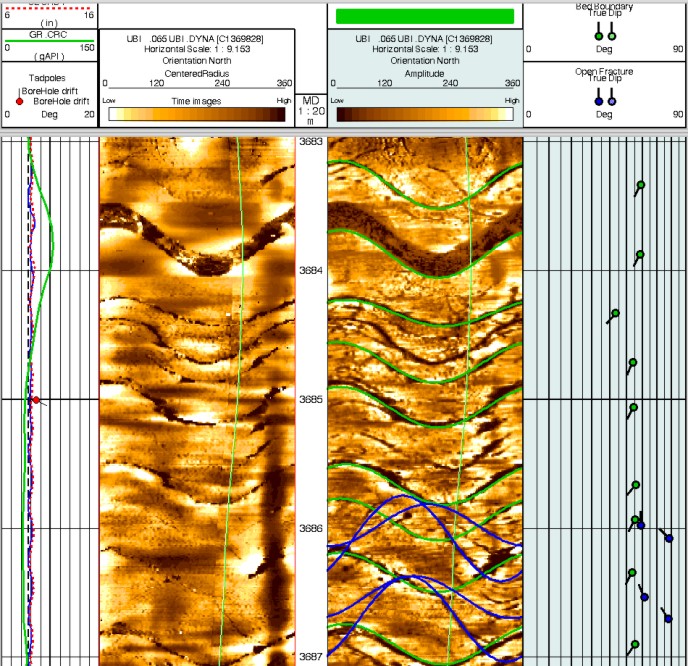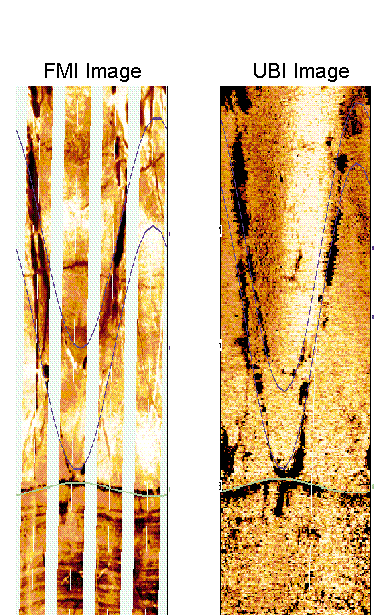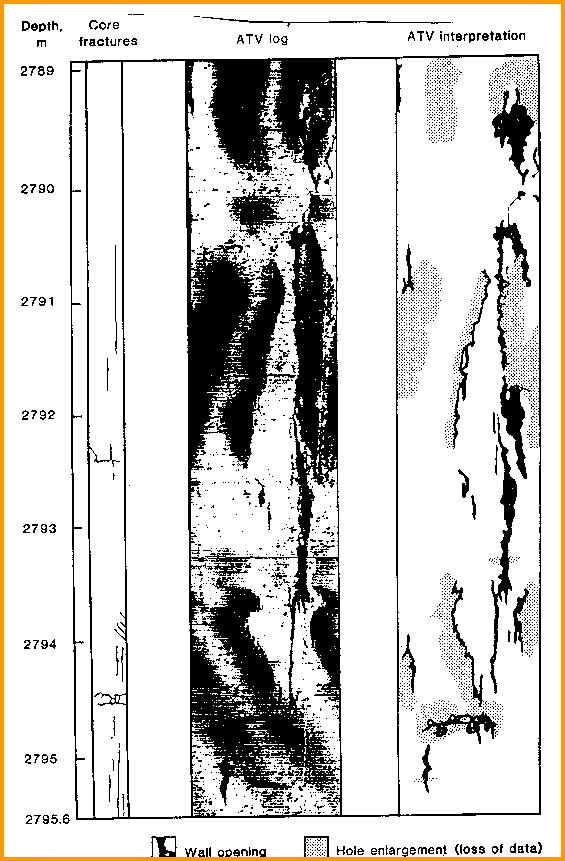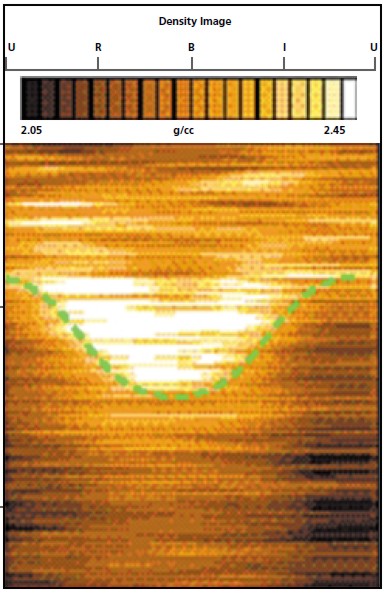|
 ACOUSTIC IMAGE LOG BASICS
ACOUSTIC IMAGE LOG BASICS
This page describes acoustic image
logs profiles, in the order of their appearance over the
years. This presentation style provides insights into tool
evolution, and a specific tool’s capabilities and
limitations. You will find most these tool types in your
well files – here’s your chance to learn more about them.
Acoustic image logs are an economic replacement for resistivity
image logs for assessing structure
and stratigraphy of reservoir rocks and for Identification of
fracture intensity and fracture orientation. Tool design has improved
considerably since its introduction. Acoustic image logs are
identified by numerous tradenames that might not easily be
recognized, such as continuous borehole image log (CBIL) and
ultrasonic borehole imaging log (UBI).
This tool is sometimes called a borehole televiewer but it should not be
confused with borehole television systems that can take continuous
video images of a wellbore filled with a clear liquid or air.
The
acoustic image log provides formation images in liquid filled open holes. In cased hole, the same tool
is used as a cement and pipe integrity tool, but it does not provide
any reservoir property information.
The tool
has roots back to the 1970's and uses a rotating acoustic
transducer/receiver operating at ultrasonic frequencies. The
travel time of the sound from the transducer to the wellbore
wall and back to the receiver is measured. This provides a
complete image of wellbore diameter (a caliper log). Black colour indicates large diameter, white is "near" bit size.
Fractures and wellbore breakout are easily seen (black). The
poor resolution on older tools makes these artifacts larger than
life and were quite misleading as to the width of fractures.
Even modern logs exaggerate fracture width.
The
log also records the amplitude of the sound signal reflected from
the borehole wall. This is a measure of the acoustic impedance of
the rock. Low values represent shale or soft sandstone (shaded black
on the log) and high values represent competent rock such as
cemented sandstones or carbonates (shaded white on the log).
Fractures and breakout will appear black, as on the caliper image.
Colours or grey-scales can be stretched or squeezed to enhanced particular
features. Dipping beds appear on the image as sine-wave patterns.
The amplitude of the sine-wave indicates dip angle and the valley of
the sine-wave indicates downdip direction.

Ultrasonic (acoustic) image log;
travel time image (left) indicates borehole diameter, amplitude
image (right) shows acoustic impedance, dips calculated from image
show both bedding (green) and fracture (blue) dips. The dark areas
on the travel time image show borehole elongation in the NW-SE
direction, with maximum stress direction at right angles to this
axis. On real logs, check heading carefully, as travel time and
amplitude images can be interchanged in position, and North may be
on the right or the middle of the track.
A
resistivity image log has about 10 times the spatial resolution of an
acoustic image log
and 500 times the amplitude resolution, due to the difference
in contrast between the resistivity and acoustic impedance ranges
measured by the respective tools.

Comparison of resistivity image
log (left) and ultrasonic image log in the same borehole. The higher
spatial resolution and the higher dynamic range of the resistivity
image is clear. Black colour represents low acoustic impedance on
CBIL/ UBI, or low resistivity on FMI, in this case representing
fractures (near vertical) or shale beds (near horizontal).
 OLDER
ACOUSTIC IMAGE LOGS
OLDER
ACOUSTIC IMAGE LOGS
Older acoustic image logs have even
poorer resolution than current versions. If you are working with
older logs that exist in the well files, be cautious in using them.
Fracture apertures are usually extremely over emphasized.

Older acoustic image log (left) and interpretation
image (right). The large apparent fractures seen on older logs
led many people to believe that fracture apertures were very
large (many millimeters), when they are really quite small (less
than a millimeter).
The
resolution of the tool allows us to determine events of about
10 mm in width. Fractures are often accentuated in the wellbore
by the drilling process, which breaks out the fracture on both
sides of the opening. If it were not for this breakout, most fractures
would not be seen by the acoustic imaging log, as their width is
commonly less than 1 mm.
Considerable
research has being conducted to enhance the images,
using both arrival time and amplitude of the sound waves, plus
computer methods for image enhancement, especially edge enhancement
to resolve fractures and bed boundaries. Modern acoustic image logs
can be used effectively in more rugged boreholes than older versions
because of the new processing techniques. Be aware of the age
of the log before you start your analysis.
The
example below shows an older acoustic image log over a portion of a hole
with a vertical fracture intersecting the borehole. The image
is displayed as a 360 degree unwrap with East at the center of
the image, and as an equivalent core image, with South in the
middle.

Acoustic image in vertical fracture in a vertical
hole
Notice
the enlarged borehole in some of the thin shale beds. The fracture
plane is far from smooth and it wanders from one side of the borehole
to the other. A dipmeter or older FMS might miss this fracture,
or indicate discontinuous vertical fractures. Light colors are
higher acoustic impedance, probably dolomite versus darker colored
limestone and limey shales. Shale beds are black and washed out.
Below is
a drill pipe conveyed acoustic image log run over a 1500 foot horizontal
stretch from the intermediate casing shoe. The zone is an upper
Cretaceous chalk in which fractures play a vital role in productivity.
Most vertical wells penetrate only one or two fractures and deplete
quickly. A horizontal well can penetrate many fractures and production
can be significantly enhanced.

Acoustic image log with vertical fracture in a horizontal
hole
The
acoustic image and uranium precipitation shown on the spectral
gamma ray log indicate fractures clearly (top image in
illustration above).
This allows the operator to position completion hardware, such
as centralizers and external inflatable casing packers correctly.
In this example, the hole was designed to run close to the top
of the chalk, and it penetrated the marly zone above in a few
places, shown by the dark bands (lower image in illustration
above).
 LWD
ALTERNATIVES TO
ACOUSTIC IMAGE LOGS
LWD
ALTERNATIVES TO
ACOUSTIC IMAGE LOGS
 Aside
from open hole resistivity image logs, there are other alternatives
to acoustic images. Aside
from open hole resistivity image logs, there are other alternatives
to acoustic images.
Logging while drilling (LWD) offers many alternatives that can be
displayed as an image log. The example at right is a density image
log. Low density values are shaded dark and can be interpreted as
porosity or shale. A gamma ray log run with the drill string helps
distinguish between these alternatives. White colours represent low
porosity or tight rocks.
Resistivity and acoustic images
are currently in the field testing stage and may become commercial
as LWD logging tools.
|

